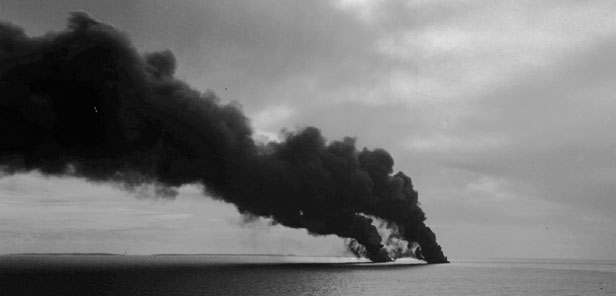On February 19, 1967, the Torrey Canyon left the oil refinery of Al Ahmadi in Kuwait. The supertanker was heading for Milford Haven, Wales, United Kingdom after circumventing South Africa. She was transporting 120,000 tons of crude oil. Built in 1959 in the United States by Newport News Shipbuilding, she was jumboized in 1965, and lengthened from 247 to 297 meters; her initial capacity of 60,000 tons was doubled. She was the pride of oil shipping companies.
On March 18, 1967, the Torrey Canyon, due to a faulty navigation, was impaled on the reefs between the Isles of Scilly and Cornwall.
Two months later, the aftermath of the shipwreck was taking a heavy toll – 150 kilometers of polluted shores in Southeast United Kingdom. Thousands of birds covered in oil came across the English Channel and were washed up dead or dying up from Calais to the Ile d’Yeu, France. The coastline was in mourning from the peninsula of La Hague to the tip of Brittany. The Channel Islands were wearing black.
For the first time, the expression “Black Tide” was on the front page of the news.
 Bombing of the Torrey Canyon.
Bombing of the Torrey Canyon.
After she ran aground, the size of the Torrey Canyon was seen as her downfall.
Fifty years later, the average capacity of a crude oil tanker is 300,000 tons.
The Torrey Canyon was named after an oil well in California and owned by the Bermuda-based Barracuda Tanker Corporation. She was chartered by the Union Oil Company of California and sub-chartered for her fatal voyage by BP, British Petroleum. She was sailing under the Liberian flag and her crew was Italian. When, against all odds, the English catastrophe also became a catastrophe for the West of France, Christian Fouchet, the Minister of the Interior, declared that sailing under a flag of convenience was defying the rules of the civilized world and assimilated this emerging practice to piracy.
Fifty years later, 71% of the world merchant fleet sails under flags of convenience.
At the end of March 1967, confusing the Torrey Canyon with the Scharnhorst or the Bismarck, the Royal Air Force dropped firebombs and napalm rockets on the wreck, and spred tons of kerosene over the ocean, in order the crude to burn and vanish. The raid failed. The pumping of tanks would have been possible according to the experts at the time.
Fifty years later, the practice has been abandoned and bombing oil reserves is restricted to war fields, where it is already too much.
The United Kingdom used 10,000 tons of chemical dispersants to divide, disperse, and “erase” the crude oil slicks. This practice which only adds pollution to pollution has widely been abandoned, but nevertheless persists.
Forty-three years later, as previously stated, chemical dispersants which are toxic for fauna and flora, fish farming and oyster farming, were widespread during the oil spill of the Deepwater Horizon platform, owned by BP, British Petroleum, in the Gulf of Mexico.
The black tide of the Torrey Canyon was spread out into a vast legal vacuum. The community of maritime States was focused on the oil pellets covering the beaches, which did not spare a single foot or a single child during the holidays. The draft of international law and national regulations were concentrated on degassing and discharges of residues from tank clean-up at sea. The shipwrecks, the collisions, and the groundings were not considered, despite a number of revealing previous indicators, since they were more discrete. The Torrey Canyon was also the beginning of the seizing of ships to pay reparations to the victims of hydrocarbon pollution. France was the first to do so, in July 1968 with the seizure in Rotterdam of another tanker owned by the Barracuda Tanker Corporation to obtain partial compensation for the costs incurred.
Fifty years later, the framework is reinforced by a set of measures: nautical, such as the required traffic separation scheme; legal, such as the affirmation and extension of the right to intervene of coastal states; financial, such as the International Oil Pollution Compensation Funds (IOPC); international, such as the MARPOL convention, the International Convention for the Prevention of Pollution from Ships; and technical, such as the requirement for tankers to have a double hull.
The waste from the Torrey Canyon were picked up haphazardly, stored quickly, treated roughly, exported up to the Parisian region by the army and buried in memories. It was only in September 2011 and February 2012 that on the Ile d’Er, near Paimpol, the pits dug in spring 1967 containing the waste from the Torrey Canyon were finally emptied. The waste were burnt in a specialized incinerator near Le Havre. In 2012, thanks to cooperation between the Minister of Ecology, Robin des Bois, and the BRGM (Bureau de Recherches Géologiques et Minières – the French office of geological and mineral research), all the stockpiles of waste from the historic “Black Tides” in the departments of Finistère and the Côtes d’Armor were listed, geolocated, and memorized. There are 188 (1).
Thirty-three years after the Torrey Canyon, the Erika shipwreck marked a breach in the “Black Tide” waste management in Europe. The stockpiles were inventoried from the beginning of the crisis. Waste were then regrouped and treated in Donges in the estuary of Loire River under the control of State services and a Local Commission of Information and Surveillance (CLIS) and under the technical and financial responsibility of the cargo owner, the company Total.
(1) Only in French :
BASIAS http://www.georisques.gouv.fr/dossiers/basias/residus-maree-noire
and a study from BRGM https://robindesbois.org/wp-content/uploads/Synthese_Etude_Maree_Noire_2012.pdf
 Imprimer cet article
Imprimer cet article








